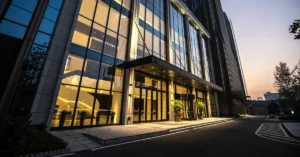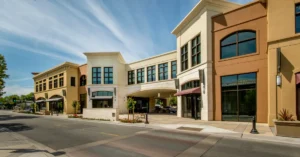Discover the Latest Tenant Improvement Trends to Enhance Your Commercial Property
As businesses in California evolve, so do their commercial space needs. Tenant improvement is no longer just about aesthetics — it’s a strategic investment that adds value to commercial properties and attracts high-quality tenants.
But what is tenant improvement, and how does it impact the functionality and appeal of a commercial building? It refers to the modifications made to a commercial space by the tenant or landlord to better suit business needs. This process often involves contractors who specialize in transforming interiors to meet specific operational requirements.
In this post, we’ll explore five key trends in commercial upgrades that are redefining how companies use their workspaces and how quality improvements can enhance your property’s value.
Flexible and Modular Spaces
Embrace Flexibility: Modular Spaces for Changing Business Needs
One of the leading trends is the creation of flexible and modular environments. These designs allow businesses to adapt their office layouts quickly, a feature particularly valuable in fast-paced industries like technology and startups. By working with experienced construction teams, companies can implement movable walls, modular furniture, and floor plans that foster collaboration and efficient space usage.
For example, a tech company might need to reconfigure a meeting room into an open workspace for a growing team. Modular environments provide the freedom to make these changes without extensive construction. This not only saves time and money but ensures that the space evolves with business growth.
Moreover, modular designs offer cost savings since non-permanent changes are easier to implement and modify. Flexible layouts remain one of the most popular solutions for maximizing commercial space.
Sustainable and Green Building Enhancements
Going Green: Sustainable Improvements in Commercial Buildings
Sustainability has become an integral part of commercial property enhancements across California. Today’s tenants seek eco-friendly spaces that align with their values and reduce operational costs. But what does this look like in practice? It involves upgrades that help a building meet green standards — including energy efficiency, water conservation, and sustainable materials.
Examples include using recycled products, energy-efficient lighting, solar panels, and low-flow fixtures. Collaborating with green-focused contractors ensures commercial spaces reduce their environmental footprint while meeting certifications like LEED. These enhancements not only lower utility bills but also appeal to environmentally conscious employees and clients.
A focus on sustainability isn’t just a trend — it’s an investment in long-term environmental and financial benefits. As costs become more competitive, it’s easier for property owners and tenants to integrate green practices into their workspaces.
Technology Integration and Smart Building Solutions
 Tech-Forward Spaces: Smart Technology for Modern Tenants
Tech-Forward Spaces: Smart Technology for Modern Tenants
Smart technology is redefining commercial upgrades, making properties more efficient, secure, and responsive. In this context, it means integrating systems that automate and enhance how a space operates — providing convenience and boosting productivity.
Examples include the installation of IoT (Internet of Things) devices for lighting, HVAC, and security systems, as well as advanced building management solutions. For instance, smart lighting that adjusts based on occupancy can reduce energy costs and create a more comfortable environment.
Contractors are seeing growing demand for these solutions, especially in sectors like tech, finance, and media. These upgrades give tenants more control over their environment and improve the workplace experience.
Wellness-Centric Design
Designing for Wellness: Spaces that Prioritize Health and Well-being
A key focus in modern construction is on wellness-oriented designs that promote health and productivity. These upgrades aim to enhance the physical and mental well-being of a space’s occupants.
Popular improvements include incorporating natural lighting, enhanced air quality systems, ergonomic workstations, and biophilic elements such as indoor plants and nature-inspired aesthetics. For example, purified air systems and nature-themed designs have been shown to reduce stress and increase employee productivity.
While wellness enhancements may come with higher upfront costs, they offer long-term benefits in employee retention, satisfaction, and overall performance — making them a valuable investment for both tenants and property owners.
Collaborative and Social Spaces
Fostering Collaboration: The Rise of Social and Collaborative Zones
Tenant improvement contractors are increasingly focused on creating collaborative and social spaces within commercial environments. With a growing emphasis on teamwork and innovation, businesses are looking to add communal zones such as break-out areas, lounges, and flexible meeting rooms as part of their tenant improvement construction efforts.
These spaces not only foster collaboration and spontaneous interaction but also support employee engagement. Many tenant improvement projects now feature social areas that encourage casual meetings and creativity, particularly in industries where teamwork is crucial.
For example, a startup might want to convert part of its office into a multifunctional social zone where employees can brainstorm or relax between tasks. Tenant improvement meaning in this context includes designing spaces that balance work and relaxation, making the office a more appealing and productive environment.
By incorporating collaborative spaces, businesses can enhance their work culture and improve employee satisfaction—both of which contribute to the overall success of the company.
FAQ:
Q: What is an example of a tenant improvement?
A: An example of a tenant improvement is converting an open office space into individual workstations by installing modular walls or partitions. Other common tenant improvements include upgrading lighting fixtures to energy-efficient LEDs, adding ergonomic furniture, improving indoor air quality systems, or integrating smart building technology like automated temperature and lighting controls.
Q: What is another word for tenant improvement?
A: Another term for tenant improvement is leasehold improvement. Both terms refer to the modifications or alterations made to a commercial space to better suit the tenant’s business needs.
Q: What is the difference between tenant improvement and building improvement?
A: Tenant improvements are specific modifications made to a leased space by the landlord or tenant to meet the tenant’s business requirements. These changes often benefit the tenant directly, such as partitioning rooms or upgrading fixtures, and are usually done within the tenant’s leased area.
Building improvements, on the other hand, refer to structural or major upgrades that affect the entire property. These can include adding elevators, upgrading the HVAC system, or renovating the exterior façade. Building improvements benefit the entire property and are typically undertaken by the property owner rather than an individual tenant.
Q: What is the formula for tenant improvement?
The formula for calculating tenant improvement allowance (TIA) typically depends on the agreed-upon amount between the tenant and the landlord. It is often calculated per square foot of the leased space. For example, if a tenant improvement allowance is set at $40 per square foot and the space is 5,000 square feet, the total tenant improvement budget would be:
Tenant Improvement Allowance = Square Footage × Allowance per Square Foot
In this case:
5,000 sq. ft. × 40 USD = 200,000 USD
This formula helps both the landlord and tenant determine the budget for improvements that will be made to the space based on the lease agreement.
Transform Your Commercial Space with Expert Tenant Improvement Construction
 Looking to enhance your commercial space with expert tenant improvements? Trust Iron Mechanical, your go-to commercial builder in California specializing in tenant improvement construction. With a deep understanding of commercial functionality and design, we create spaces that not only reflect your brand but also support productivity and well-being.
Looking to enhance your commercial space with expert tenant improvements? Trust Iron Mechanical, your go-to commercial builder in California specializing in tenant improvement construction. With a deep understanding of commercial functionality and design, we create spaces that not only reflect your brand but also support productivity and well-being.
Whether you need flexible floor plans, energy-efficient systems, advanced HVAC integrations, or wellness-focused upgrades, our team delivers tailored solutions that align with your operational goals. We focus on smart building technologies and sustainable practices to ensure your space meets today’s standards—and tomorrow’s demands.
As a trusted commercial builder, Iron Mechanical has the experience, technical knowledge, and commitment to quality needed for complex tenant improvement projects. From open-plan offices to medical suites and retail environments, we handle everything from HVAC retrofits to complete interior build-outs.
Contact Iron Mechanical today for a consultation and discover how we can transform your commercial property into a modern, efficient, and sustainable workspace that meets all your business needs. Call us now to get started!
